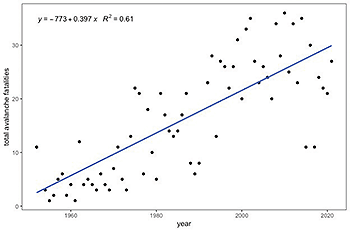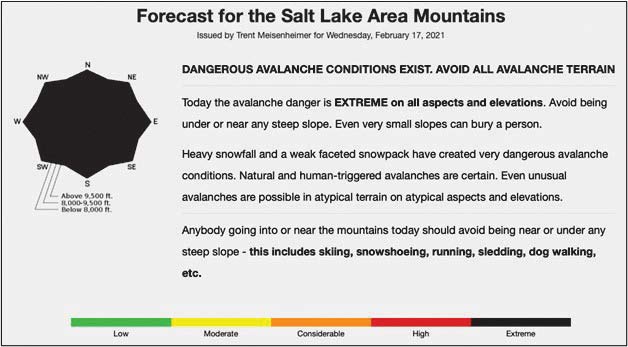 |
| Figure 1. Annual avalanche fatalities from 1951-2021 for all Western US States. Data sourced from Colorado Avalanche Information Center. |
Avalanches killed 21 people in February 2021, in fact within the time we started writing this article we had to update this number nearly every day to account for new deaths. So far 28 people have been killed by avalanches in the 2020-2021 season. Fifteen of those people died in the first week of February, making it the second deadliest week from avalanche related deaths since 1910 -- when an avalanche hit a train going from Seattle to Spokane and killed 96 people on board. So what is going on and why is this month so deadly?
To begin, it is important to note that avalanche deaths have been increasing over the past century (Fig 1), with the highest spike in the mid-2000’s. However in recent years, it seems deaths have actually begun to decrease in many states (Fig 2) likely attributed to increasing awareness programs like Know Before You Go, training, and technological developments in avalanche safety gear. However, February 2021 has most certainly been an exception, especially in Colorado and Utah (Fig 3) which have already reached their highest and second highest deaths/year on record, respectively. Fortunately science and public outreach is on our side, and we can learn from this season’s avalanche accidents and stay on top (and not below) the greatest snow on Earth.
 |
| Figure 2. Avalanche fatalities between 1951-2021 for Western US states. Data sourced from Colorado Avalanche Information Center. |
Two important factors are contributing to this year’s high fatality rate. The first is related to global climate patterns and the second has to do with decision making while traveling in the backcountry. The Western US has been in a persistent drought due to a strong La Nina Southern Oscillation that began in October 2020. A couple small, early season storms followed by a mostly dry December and January left us with a persistent weak layer of snow across much of the Western US. The weakening of La Nina in February finally brought the much needed precipitation, and piled huge layers of powder upon Utah’s weak snowpack. When fresh (and especially wet-dense) snow falls on top of a poorly structured snowpack, you have the potential to collapse the weaker layers underneath because they cannot support the load. In such conditions, steep slope angles become dangerous because they have a tendency to avalanche. Avalanche terrain is often characterized as being on or underneath slopes greater than 30 degrees though wind loading and micro terrain are factors as well. Avalanche forecasters across the West have predicted and warned of high avalanche danger due to heavy snowfall in the past month. On Feb. 15th the Utah Avalanche Center issued an unprecedented “EXTREME avalanche danger across all aspects and elevations in the Wasatch Range outside of Salt Lake City .” (Fig 4) Though most recreational avalanche accidents don’t happen on extreme danger days, backcountry travelers are pushing the limits on a touchy snowpack. The avalanche accident reports from this month have a common denominator; backcountry recreationists were traveling in avalanche terrain when the forecasted danger was considerable to high and mostly likely on windloaded North to Northeast aspects. So if there’s a high chance of avalanches, why does it seem like the backcountry community is taking more risks this year?
 |
| Figure 3. Avalanche fatalities in 2021 avalanche season (Oct 1, 2020 through February 19, 2021) by state. Solid vertical line represents the annual mean fatalities for each state and how they compare to this year’s fatalities. Data sourced from Colorado Avalanche Information Center. |
Avalanche reports from the past month have shared accounts from survivors or witnesses who describe the events leading up to, during, and after the avalanche. Some believe they were recreating in “safe” or familiar terrain and were appropriately mitigating risks when the accident occured. Often too many of those caught and killed are competent backcountry recreationalists with years of experience and even oftentimes professionally trained. The NY Times reported that backcountry recreators may be taking more risks this year and perhaps, due to stress associated with the pandemic, are experiencing lapse in judgement when traveling in the backcountry. More people are also trying to avoid crowds while recreating (with or without COVID), and therefore many are opting for backcountry skiing over resorts. Increasing numbers of pandemic stressed backcountry travelers who are experiencing risk mitigation decision fatigue mixed with a persistent weak layer and dangerous snow conditions have made for the perfect storm this avalanche season. The pandemic has brought about a plethora of economic and social side effects. We can all sympathize with these year’s victims and our hearts go out to their family members and loved ones. Ski to ski another day.
Check out Utah’s Avalanche Center and United States avalanches information:
https://utahavalanchecenter.org/
https://avalanche.org/
https://kbyg.org/#home
 Figure 4. Utah Avalanche Center Forecast for Salt Lake City on Wednesday February 17, 2021. Figure 4. Utah Avalanche Center Forecast for Salt Lake City on Wednesday February 17, 2021.
|